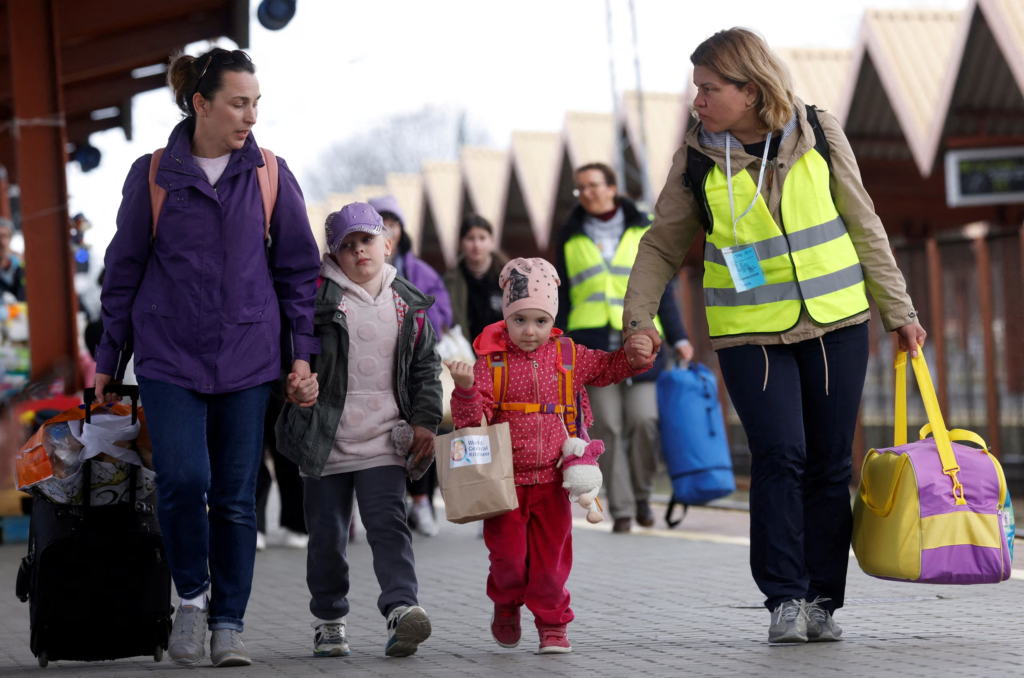The ongoing conflict between Russia and Ukraine has not only caused widespread destruction and displacement but has also had a significant impact on Ukraine’s demographic landscape. Since Russia’s annexation of Crimea in 2014 and the full-scale invasion in February 2022, Ukraine’s population has experienced a dramatic decline.
According to the United Nations Population Fund (UNFPA), Ukraine’s population has decreased by around 10 million since 2014, with approximately 8 million of that loss occurring since the invasion in 2022.
This staggering reduction is the result of a combination of factors, including the mass exodus of refugees, the plummeting birth rate, and the high casualties of the war. As Ukraine continues to face military aggression and political instability, the population crisis is emerging as one of the long-term consequences of the conflict.
A Nation in Crisis: The Impact of War on Ukraine’s Demographics
Ukraine’s population decline began in 2014 when Russia first invaded and annexed Crimea. At the time, the country had an estimated population of 45 million people, but since then, the combination of territorial losses, ongoing conflict in the eastern regions, and emigration has caused a steady decline.
By 2022, just before Russia’s full-scale invasion, the population had already dropped to around 43 million. However, since the start of the full-scale invasion, the decline has accelerated dramatically, with the population falling to an estimated 35 million by 2024.
One of the primary drivers of this population decrease has been the mass displacement of people fleeing the conflict. Since 2022, approximately 6.7 million Ukrainians have left the country, seeking refuge in neighboring European nations and beyond.
Read : Russia Loses 1,340 Soldiers In Just 24 Hours Amid Ongoing Ukraine War
The scale of this exodus is unprecedented, creating a humanitarian crisis that has strained resources in both Ukraine and the countries that have taken in refugees. As the war continues, many of those who fled may not return, especially as the destruction of homes, infrastructure, and basic services makes it difficult to envision rebuilding their lives in war-torn regions.
In addition to the refugees, the war has resulted in tens of thousands of casualties, further contributing to the decline in Ukraine’s population. While neither Ukraine nor Russia have officially released casualty figures since the start of the invasion, estimates from U.S. officials in 2023 suggested that at least 70,000 Ukrainian soldiers had been killed.
Read :NATO Members Pledge 40 Billion Euros in Military Aid for Ukraine in Washington Summit
This figure does not account for the many civilians who have also lost their lives in the conflict. The loss of so many lives, combined with the departure of millions of refugees, has left a significant void in Ukraine’s population, particularly among the working-age and younger generations.
A Sharp Decline in Birth Rates: The Challenges of Rebuilding a Population
Another major factor contributing to Ukraine’s population decline is the dramatic drop in the country’s birth rate. Even before the war, Ukraine had one of the lowest birth rates in Europe, with many young people choosing to leave the country in search of better economic opportunities abroad.
However, the conflict has exacerbated this trend, with the birth rate now plummeting to one of the lowest in the world—around one child per woman. This is far below the replacement rate of 2.1 children per woman, which is necessary to maintain a stable population size.

The war has created an environment of uncertainty and instability, making it difficult for families to plan for the future. Many young couples have postponed having children due to the dangerous and unpredictable circumstances, while others have been separated by the conflict, with men staying behind to fight and women and children fleeing to safety in other countries.
The economic challenges brought on by the war, including job losses, rising inflation, and the destruction of infrastructure, have further discouraged families from expanding.
The decline in birth rates is particularly concerning for Ukraine’s future. A shrinking population can lead to long-term economic challenges, including a reduced labor force, slower economic growth, and increased pressure on social welfare systems. As Ukraine works to rebuild in the aftermath of the war, the country will face the additional challenge of revitalizing its population and encouraging the return of refugees, as well as creating conditions that are conducive to raising families once again.
The Long-Term Consequences of Population Decline: Rebuilding Ukraine After the War
Ukraine’s population decline poses significant challenges for the country’s future, particularly as it looks toward recovery and rebuilding in the post-war era. The loss of millions of people—both through displacement and casualties—has created a demographic gap that will be difficult to fill. The labor force has been severely depleted, and the loss of young, educated citizens who have sought refuge abroad could hinder the country’s ability to recover economically.
The war has also exacerbated existing regional disparities, with some areas of Ukraine being more severely affected than others. The eastern regions, which have been the focus of much of the fighting, have seen widespread destruction and displacement, while other regions have experienced less direct impact.
However, the economic and social consequences of the war have been felt nationwide, and addressing these challenges will require coordinated efforts at both the national and international levels.
One of the key priorities for Ukraine in the coming years will be to encourage the return of refugees. Many Ukrainians who fled the conflict have established new lives in host countries, finding jobs, housing, and educational opportunities for their children.

Convincing these refugees to return will require significant investments in rebuilding infrastructure, ensuring security, and creating economic opportunities in the war-torn regions. This will not be an easy task, as many areas of Ukraine remain unstable, and the process of reconstruction is likely to be slow and costly.
In addition to addressing the needs of refugees, Ukraine will also need to focus on boosting its birth rate. This may require a combination of policies aimed at supporting families, including financial incentives for having children, improved access to healthcare and childcare services, and efforts to create a more stable and secure environment for raising families.
Encouraging population growth will be essential for rebuilding Ukraine’s economy and ensuring that the country has the human capital necessary to thrive in the future.
The international community will also play a critical role in supporting Ukraine’s recovery. Humanitarian aid, financial assistance, and technical expertise will be needed to help Ukraine rebuild its infrastructure, support its displaced population, and address the long-term consequences of the war.
International organizations like the United Nations, as well as Ukraine’s European and Western allies, will be instrumental in providing the resources and support necessary to address the country’s population crisis.

The population decline in Ukraine is one of the most tragic and far-reaching consequences of the ongoing war with Russia. Since the invasion of Crimea in 2014, and particularly since the full-scale invasion in 2022, Ukraine has lost approximately 10 million people—through displacement, declining birth rates, and casualties.
This demographic crisis poses significant challenges for Ukraine’s future, as the country faces the daunting task of rebuilding its population, economy, and infrastructure in the aftermath of the war.
The war has not only claimed lives and displaced millions but has also created an environment of instability and uncertainty that has further exacerbated the population decline. Ukraine’s government, in cooperation with the international community, will need to address these challenges head-on in order to create the conditions necessary for recovery and growth.
Encouraging the return of refugees, boosting birth rates, and rebuilding war-torn regions will be essential steps in ensuring that Ukraine can emerge from this conflict stronger and more resilient.
let’s enjoy few years on earth with peace and happiness….✍🏼🙏

